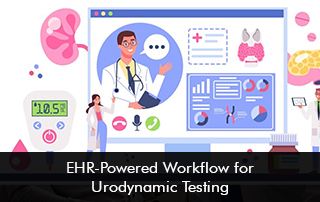Urodynamic testing is a specialized procedure in urology focused on diagnosing issues related to urinary function. This diagnostic process requires precision and efficient workflows, as well as accurate and accessible records for patients undergoing these tests. EHR (Electronic Health Record) systems play a crucial role in managing the intricacies of urodynamic testing workflows, from initial appointments to post-test follow-ups. By integrating EHR solutions into urodynamic testing, urologists can streamline the entire process, enhancing care quality, increasing efficiency, and minimizing human error.
Urology practices utilizing EHRs for urodynamic testing benefit from automated scheduling, integrated data access, and streamlined documentation. These advantages not only improve clinical outcomes but also enhance patient satisfaction. Below, we’ll examine how EHR technology improves urodynamic testing workflows, highlighting the top features, patient experience benefits, and leading software solutions in the urology specialty.
How EHR Enhances Urodynamic Testing
Automated Appointment Scheduling and Reminders
-
- Simplifies the scheduling process, allowing staff to allocate time slots efficiently and avoid double-booking.
- Automated reminders reduce no-shows and ensure that patients are prepared for their tests.
Data Integration and Seamless Access to Patient Records
-
- EHRs provide instant access to complete medical histories and previous test results, which helps urologists better understand each patient’s unique condition.
- Integrated data enables urologists to make informed decisions and personalize diagnostic approaches.
Detailed Documentation and Compliance
-
- EHRs simplify documentation by capturing detailed information during tests, including patient responses and test results.
- The streamlined documentation process helps maintain compliance with insurance and regulatory requirements, supporting accurate billing and improved claim acceptance rates.
Patient Experience and Satisfaction
- Reduces pre-test anxiety by providing patients with clear instructions and information ahead of time.
- Allows patients to access test results and care recommendations online, empowering them with knowledge and involvement in their care journey.
Top Urology EHR Software Recommendations
Athenahealth
- Focus: Cloud-based, versatile EHR system with customizable templates.
- Strengths: Known for its intuitive interface, Athenahealth supports urology practices with customizable workflows, real-time reporting, and strong patient engagement tools. Its cloud-based nature offers flexibility and easier access to updates and support.
- Best For: Small to mid-sized practices that value a streamlined, cloud-based solution with built-in revenue cycle management.
ModMed’s Urology EHR (EMA)
- Focus: Specialty-specific EHR for various practices, including urology.
- Strengths: Offers a urology-specific version that includes built-in MIPS reporting, automated scribing, and an adaptive learning algorithm that customizes workflows based on practice needs. Its mobile-friendly design is particularly useful for physicians on the go.
- Best For: Urology practices looking for a mobile, specialty-specific solution that adapts over time based on usage.
Kareo Clinical
- Focus: Primarily aimed at independent practices needing flexible documentation tools.
- Strengths: While Kareo is a general EHR, it’s highly customizable and offers tools to create urology-specific templates. It integrates easily with billing and practice management, making it ideal for smaller practices.
- Best For: Smaller urology practices or clinics seeking a straightforward, affordable solution with integrated billing.
Praxis EMR
- Focus: AI-driven, template-free EHR that adapts to individual physician workflows.
- Strengths: Praxis’s template-free design is a good fit for urologists who need flexibility to handle complex, personalized documentation. It uses artificial intelligence to adapt to the practice’s specific needs, offering robust support for narrative-style documentation and customized reporting.
- Best For: Practices looking for a highly adaptable, AI-driven EHR without the constraints of pre-defined templates.
ChartLogic
- Focus: EMR solution with strong clinical documentation tools and voice recognition.
- Strengths: ChartLogic’s focus on fast, accurate documentation (especially through its voice-recognition feature) makes it a good choice for urology practices that need efficient charting options. It’s also well-regarded for its intuitive design and customizable templates.
- Best For: Small to medium-sized urology practices that need efficient clinical documentation and voice-recognition capabilities.
Each of these options offers unique strengths for urology practices, from customizable templates and AI-driven features to strong mobile functionality and integrated billing. If practices consider one, it may help to look for a free trial or demo specific to urology needs to see how well each fits the practice’s workflow.







